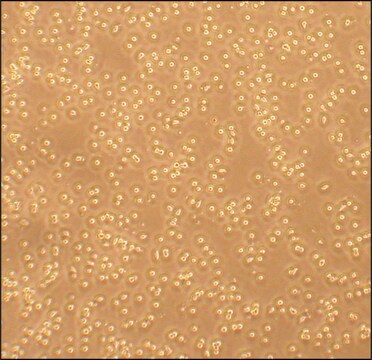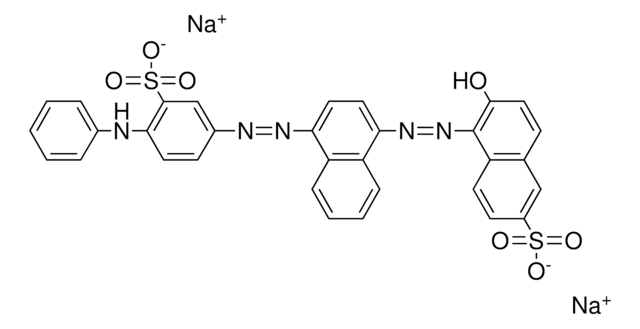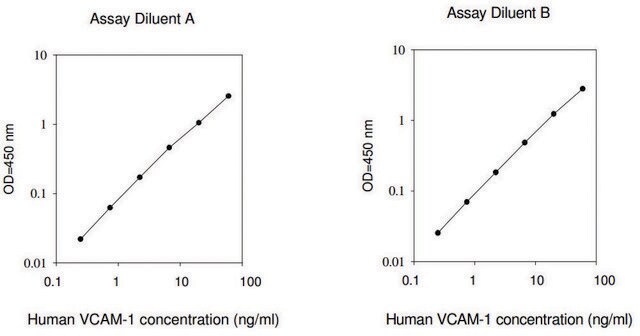SCC286
CUTLL1 Human T-cell Lymphoblastic Lymphoma Cell Line
Human
Faça loginpara ver os preços organizacionais e de contrato
About This Item
Código UNSPSC:
41106514
NACRES:
NA.45
fonte biológica:
human
modo de crescimento:
N/A
fabricante/nome comercial:
Millipore
Produtos recomendados
Nome do produto
CUTLL1 Human T-cell Lymphoblastic Lymphoma Cell Line,
fonte biológica
human
embalagem
vial of >1X10⁶ cells
fabricante/nome comercial
Millipore
modo de crescimento
N/A
técnica(s)
cell culture | mammalian: suitable
Condições de expedição
dry ice
temperatura de armazenamento
≤ − 140°C
Aplicação
T-cell acute lymphoblastic lymphoma (T-ALL) is a rare but aggressive form of non-Hodgkin lymphoma, with a high relapse rate and poor long-term survival (1). The majority of T-cell lymphoblastic leukemias and lymphomas harbors activating mutations in the NOTCH1 gene, a key signaling component required for T-cell development (2). Drugs targeting the Notch pathway are thus promising avenues for treatment of T-cell lymphoblastic leukemias. Lack of response of human T-ALL cell lines to Notch inhibitors has hampered the clinical applicability of these models.
CUTLL1 is a human T-cell lymphoblastic lymphoma cell line derived from a relapsed patient that harbors a t(7;9)(q34;q34) chromosomal translocation resulting in expression of a TCRB-NOTCH1 fusion transcript and aberrant Notch signaling (3). CUTLL1 cells demonstrate high sensitivity to gamma-secretase inhibitors, which act on the Notch pathway. CUTLL1 cells express markers of immature T-cells including CD3, CD4, CD8 and TCRαα (3).
Source:
The CUTLL1 cell line was established from pleural effusion of a relapsed 14-year-old male patient suffering from T-cell lymphoblastic lymphoma (2)
References:
1. Cancer J. 2012; 18(5): 432-8.
2. Science 2004; 306(5694): 269-71.
3. Leukemia 2006; 20(7): 1279-87.
CUTLL1 is a human T-cell lymphoblastic lymphoma cell line derived from a relapsed patient that harbors a t(7;9)(q34;q34) chromosomal translocation resulting in expression of a TCRB-NOTCH1 fusion transcript and aberrant Notch signaling (3). CUTLL1 cells demonstrate high sensitivity to gamma-secretase inhibitors, which act on the Notch pathway. CUTLL1 cells express markers of immature T-cells including CD3, CD4, CD8 and TCRαα (3).
Source:
The CUTLL1 cell line was established from pleural effusion of a relapsed 14-year-old male patient suffering from T-cell lymphoblastic lymphoma (2)
References:
1. Cancer J. 2012; 18(5): 432-8.
2. Science 2004; 306(5694): 269-71.
3. Leukemia 2006; 20(7): 1279-87.
Características e benefícios
The CUTLL1 cell line is a valuable and clinically relevant model for T-cell lymphoblastic lymphoma.
Armazenamento e estabilidade
Store in liquid nitrogen. The cells can be cultured for at least 10 passages after initial thawing without significantly affecting the cell marker expression and functionality.
Outras notas
This product is intended for sale and sold solely to academic institutions for internal academic research use per the terms of the “Academic Use Agreement” as detailed in the product documentation.
Exoneração de responsabilidade
RESEARCH USE ONLY. This product is regulated in France when intended to be used for scientific purposes, including for import and export activities (Article L 1211-1 paragraph 2 of the Public Health Code). The purchaser (i.e. enduser) is required to obtain an import authorization from the France Ministry of Research referred in the Article L1245-5-1 II. of Public Health Code. By ordering this product, you are confirming that you have obtained the proper import authorization.
Unless otherwise stated in our catalog or other company documentation accompanying the product(s), our products are intended for research use only and are not to be used for any other purpose, which includes but is not limited to, unauthorized commercial uses, in vitro diagnostic uses, ex vivo or in vivo therapeutic uses or any type of consumption or application to humans or animals.
Código de classe de armazenamento
10 - Combustible liquids
Classe de risco de água (WGK)
WGK 1
Ponto de fulgor (°F)
Not applicable
Ponto de fulgor (°C)
Not applicable
Certificados de análise (COA)
Busque Certificados de análise (COA) digitando o Número do Lote do produto. Os números de lote e remessa podem ser encontrados no rótulo de um produto após a palavra “Lot” ou “Batch”.
Já possui este produto?
Encontre a documentação dos produtos que você adquiriu recentemente na biblioteca de documentos.
Nossa equipe de cientistas tem experiência em todas as áreas de pesquisa, incluindo Life Sciences, ciência de materiais, síntese química, cromatografia, química analítica e muitas outras.
Entre em contato com a assistência técnica





